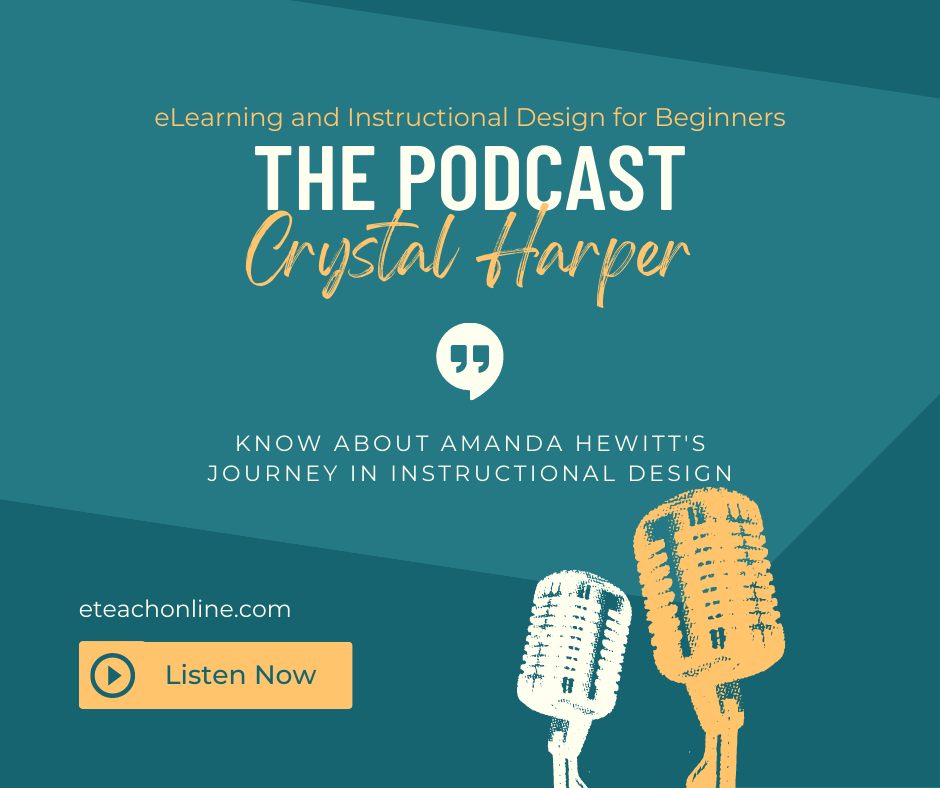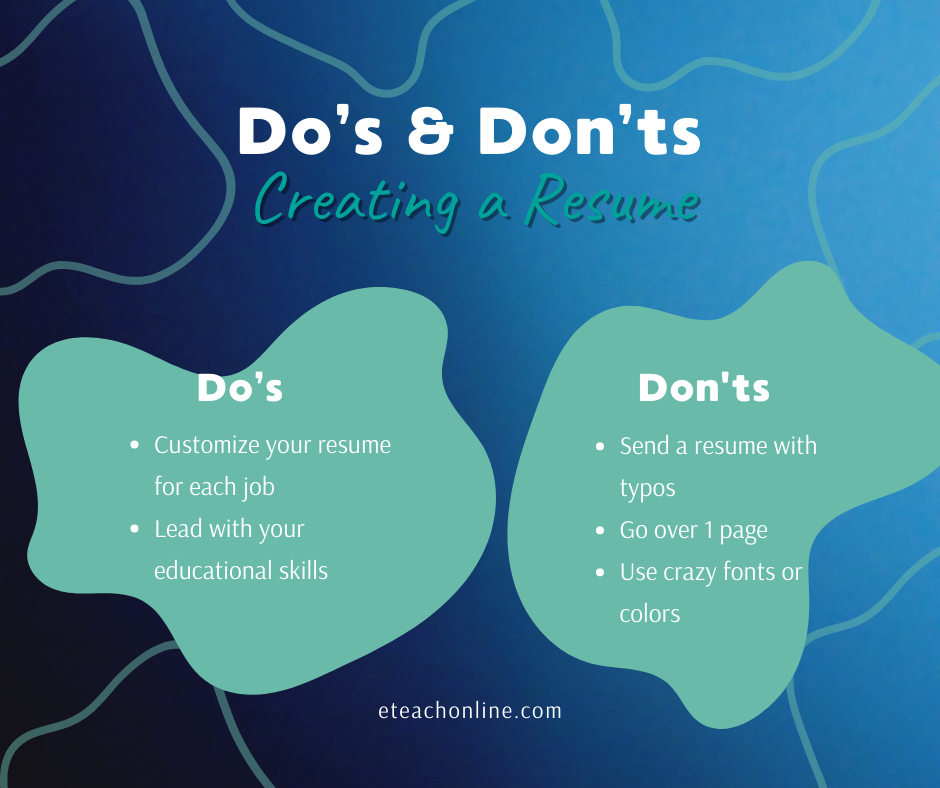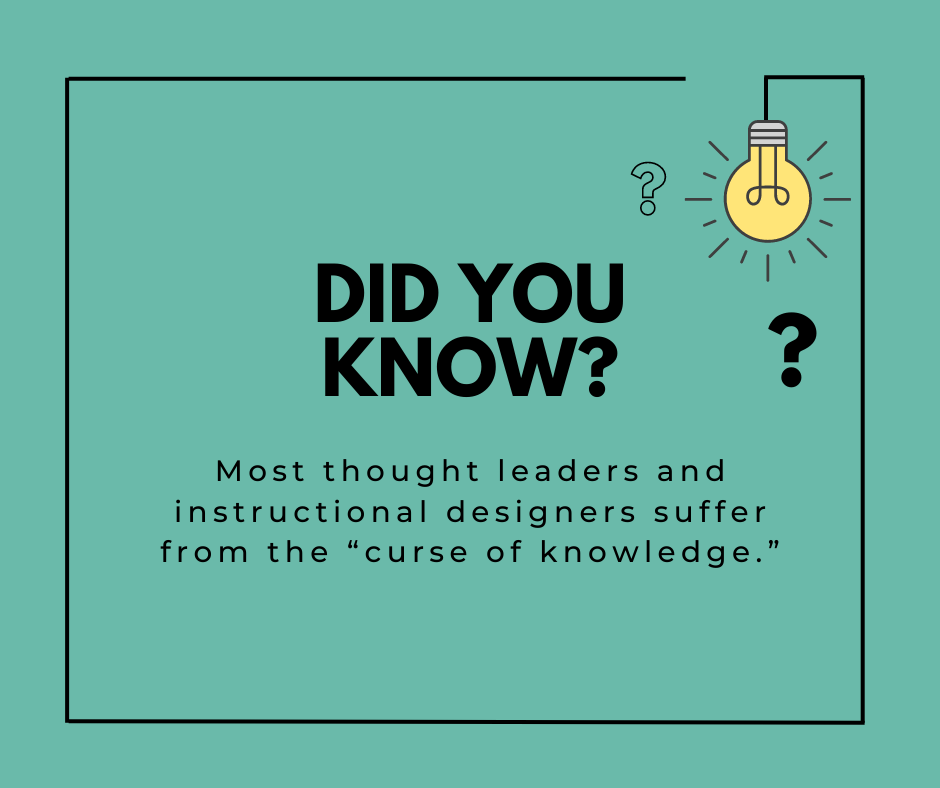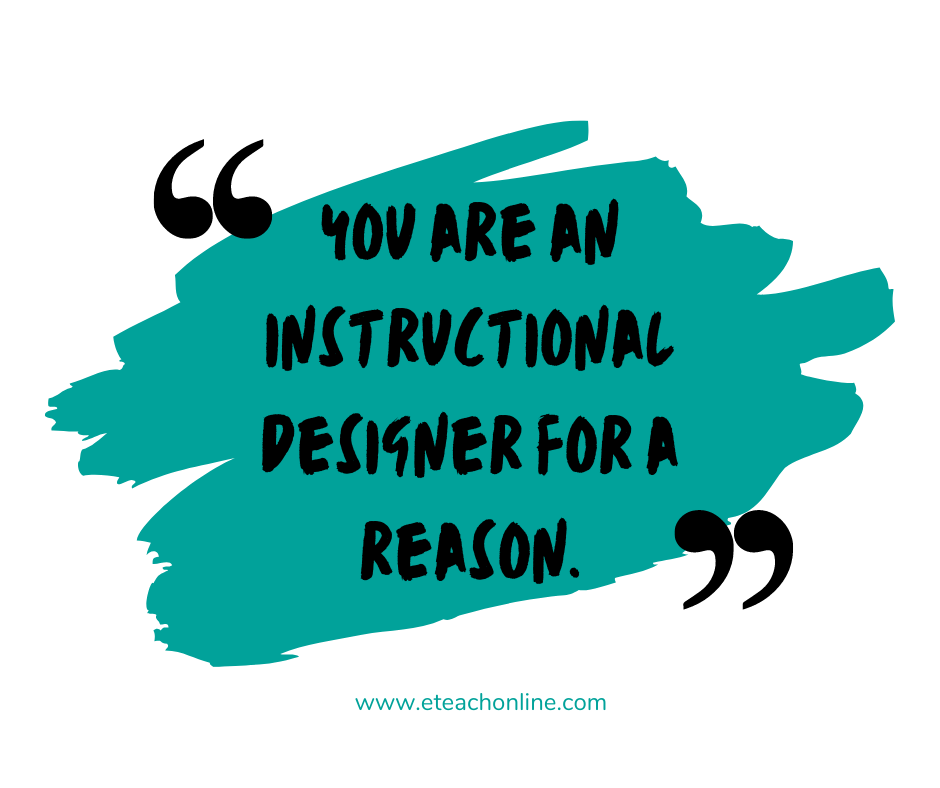Don't miss out on the opportunity to listen and download this episode's mp3 for free from my podcast. Click the link and start listening now!
SUMMARY
-
Amanda Hewitt is a senior instructional designer at DaVita, and she has a wealth of experience in the field of e-learning and instructional design. In this interview, she shares her insights on what inspired her to pursue this career path, her typical workday, and the flexibility of her job.
-
Amanda's journey in instructional design began in the higher education space, where she supported nursing and pharmacy students. Her experience in this role gave her the opportunity to navigate learning management systems, virtual proctoring, and other essential tools for e-learning. As a staff member at a college, she recognized the incredible impact she could have on a learner's journey and used her expertise to advise students on matters such as resume tips and how to balance work and school. This experience inspired her to continue down the path of instructional design, where she could use her empathy and knowledge to create impactful e-learning solutions.
-
As a senior instructional designer at DaVita, Amanda's role is multifaceted, and she emphasizes the importance of adaptability and open-mindedness. While she has a creative passion for building courses, she recognizes that the needs of subject matter experts and clients always come first. She understands that a complete course is not always the answer, and a quick reference guide or job aid may suffice. Amanda stresses the importance of having realistic expectations, especially for those who are new to the field.
-
A typical workday for Amanda involves mapping out her day, prioritizing her tasks, and working on projects such as PowerPoint flips for existing courses. While her work may not always be the most exciting, she recognizes its impact and importance. Amanda also emphasizes the importance of structuring her day and planning ahead, as this helps her manage her time effectively.
-
One of the most significant benefits of Amanda's job is its flexibility. While she typically works eight-hour days, there may be times when she works longer to meet tight deadlines. However, her company values work-life balance and does not expect her to work excessively long hours. Her leader is supportive, and her team is collaborative and communicative, making her job a fulfilling and enjoyable experience.
-
Overall, Amanda's insights into instructional design and her experiences at DaVita provide valuable information for those considering a career in e-learning or looking to improve their skills in this field. Her passion for creating impactful learning solutions and her dedication to work-life balance make her a valuable asset to the industry.
INSPIRATIONAL QUOTES







TRANSCRIPT
Today I'm speaking with Miss Amanda, a senior instructional designer at DaVita. Hi, Amanda. Welcome to the show.
Hi, Crystal, how are you doing? Good.
Thank you. What inspired you to get into elearning and instructional design?
You know, Crystal, that's a really great question. So my previous work and supporting nursing and pharmacy students in the higher ed space, you know, has honestly inspired me to teach myself how to navigate learning management systems LMS you know, virtual proctoring things like that. So, you know, a staff member at a college has such an amazing capacity to make an impact on a learner's journey, etc. So, with that being said, you know, I would sometimes advise on matters I had experience with with my nursing students, so they would stop by at my front desk to say hello and kind of vent on their exams or things like that. And I had experienced, you know, on resume tips, how to navigate working full time while going to school because at the time I was going to school at University of Illinois, Springfield, for my master's degree in public administration and strategic HR emphasis. So yeah, that's a mouthful, but yeah, I had a lot going on. So I was able to really practice my empathy with them too. I kind of knew like, Hey, I'm there too. I'm not a nurse, but I am, you know, trying to show my career and things like that. So that kind of inspires me to do that.
So what's a typical day look like for you?
You know, I'm only a few weeks in and my newly acquired role as a senior circuit designer is divided up. So generally speaking, I would say as an ad, you know, we have to be adaptable, right and open to changes. So most of us have creative passions, and we may have initial expectations on that course to build the right crystal. I'm sure you've experienced this, but the needs of our species are subject matter experts and clients come first. So first of all, I'm sure from your pets experience. A complete course is not always the answer, you know, for a learning solution. You know, QR G quick reference guide or a job aid may suffice. So it's important to have those realistic expectations unless you're a freelancer with clients and have a robust client need for full on from scratch course builds. I would say just try to have realistic expectations if that makes sense. Because right now, I'm just I can't go into huge detail but right now I'm you know, just right now I'm doing PowerPoint flips for existing courses. And it's, well it's not the most exciting work, it is impactful and things like that. So, you know, I start off my day by opening up my computer, maybe checking my email for a few minutes. I love to map out my day. So I spend five to 10 minutes mapping out my day. I love lists. I love things like that. So making sure I don't have any huge surprises. And then maybe I'll listen to a podcast or things like that, like on articulate elearning heroes or something. Like that for 30 minutes. I know we'll talk about people I follow in a little bit. But yeah, so that's and then I also have like, maybe, you know, two hours blocked out of development time. So you know, I'll have two hours, four hours, something like that. And then I'll have some team meetings, some stakeholder meetings, things like that. And then before you know it, you're eight hours up. That's kind of like a dream of life, I would say. So hopefully that answered your question. enough, fair enough. So because every ID role is different, right? So it just depends on the organization and how everything's structured.
Well, that too, and just how you personally are structuring your day and planning out your day. That's very important for, I think, anyone. It's something that a lot of people don't do, especially instructional designers. It's very important because there's so many different things going on all the time, for sure.
I'll just skip. Well, did you want to talk about how flexible your job is? Yes, I feel like I almost got it. Okay, I
can do that. So did you want to ask the question?
How flexible is your job?
So I wish I could say I worked four hours a day and took a spa day and Fridays. I'm joking. That was a joke. I don't really do that. But I'll generally work on our days. You know, you know crystal somebody's roles are salaried like buying or their hourly. So it just depends on the organization and their structure. So yeah, so generally I will work redo so I will generally work eight hour days. I'm salaried. So there may be a day where I work a little longer, for example, to work on a deliverable with a tight deadline, but that's my prerogative. My company really values that work life balance and they preach it they don't want us working 80 hours a week. So yeah, it's up to us to manage our time and there is not a lot of micromanaging on my team. I love my leader. He is amazing. And my team is really great. So yeah, that's a little bit about my day like you know, benefits and things like that. It's pretty typical of the healthcare corporate kind of space. So you know, typical PTO health benefits 401 K, things like that. So it's pretty typical if you were to compare and contrast like other health care organizations.
Yeah, that's awesome. Interior you mention how you love your team. That's super important. And it seems like pretty common instructional designers. They love their jobs and their team. So it's awesome. How has your time working in the healthcare industry impacted your approach to instructional design?
So crystal, I really loved this question when I was preparing for it. So due to my experiences in the healthcare industry, I am familiar, like how clinicians operate and how they approach certain situations. So I would say that it has shaped me more into an empathetic human with the true purpose of life, you know, which is to always try my best to help others. On a personal note, Crystal I volunteer my time on weekends and weeknights, I run two different post traumatic stress support pages, a public page, a private page and then a second page. So it's just really exciting to be able to, I design social media content, quotes, things like that. I reshare, posts, posts, articles, things like that. And it really gives trauma patients a voice, you know, and my groups are open to non combat and combat folks with PTSD. So folks who have been at war or folks who were run over by a car or had domestic abuse, unfortunately, in the home, things like that. So I would say just my experiences have really shaped me into an empathetic person. And that's your question real quick. Can I answer in the second part? Okay, perfect. So dirty? Yeah, so my journey to healthcare, surgical design and general learning and development, l&d space guys, about eight years ago, started at a local hospital in central Illinois. So yeah, I served two very busy and impactful years as a frontline health information management medical records person. So this role was one of the most challenging roles I've ever had. And it was like my first official corporate healthcare role. So my team built the best paints, phones, emails, calls and in person encounters, you know, and I was tasked with many technical things as well. So we had a lot of turnover because nobody wanted to work the second shift. I worked from 2pm to 10pm. So nobody wanted to work that shift. So I was tasked with creating job aids. And quick reference guides for the new hires, because the managers weren't really present and you know, because they worked eight to four. So that that kind of inspired me to kind of, you know, pursue instructional design in the healthcare space and I never looked back
I love that and I love how passionate you are about it, and specifically in the healthcare industry. It just, it seems like it could be a very I can see that being a very rewarding job. You seem perfect for it too. That's awesome.
It definitely is crystal and to be honest, I didn't plan on being in help, you know, the healthcare IT industry. It just kind of found me, you know, with my work and, you know, the clinical higher ed space with student development and LMS and clerical support at the nursing college St. John's in Springfield. Illinois. And then I and then I moved on to working at a pharmacy College of St. Louis, you know, and now I'm at DaVita. And before that, I was at a behavioral health organization, a little under a year. So, yeah, so it's just, isn't it amazing? Like our experiences and things like that? We don't always plan it. So yeah,
definitely. And I mean, you're here for a reason and you ended up where you're at for a reason. So I think that's super cool. What is the number one habit you've developed that has contributed to your success?
I would say a couple of things. So my ability to pick up on new software and processes quickly. And you mentioned this but my positive energy. So many folks have told me your energy is contagious, you know, and it's just, it's something special people tell me to be able to connect with folks the way I do so, you know, I'm a real people person, like I really do enjoy connecting like, an everyday person like I'll talk to you like you're my best friend. You know, like I really like to connect on that. personal level, especially with my sneeze if I can, so yeah,
I love that. And I honestly felt that before I even met you, I felt comfortable with you. So that's really cool. Yeah, that's awesome. Especially with the position you're
definitely because we can talk about trust all day, but to really to really game your sneeze trust. Well, you know, I feel like connection is important. And you know, yes, being polite. Yes. You know, no, knowing what you're doing and, you know, trying to demonstrate your skills like you know, when you're 20 minute scoping meetings and things like that, to reassure them then yes, yes, the work will get done in this lot of time. But yeah, it's definitely interesting, right, first of all, tell you what happened.
So do you have a unique process for tackling elearning design?
Thinking about this, and honestly, not the moment I'm always trying to fit in some professional development, Crystal likes time to brush up on development skills or learn something new. I think before we recorded you and I were talking about AI a little bit. And, you know, for my social media groups, I have been using AI to generate some really interesting graphics, and photos and images. Like you can Yeah, you can give a command to a chatbot and tell them imagine this image, high quality anime anime style or something like that. So or realistic, realistic, high quality things like that. So it's really cool. As you know, it's not copyrighted. So I don't want to go down that you know, open that can of worms, but it's, it's fun. It's fun to really have like that. chatbot imagines an image or an apple tree with the sunset. And then you can also say, you know, oh, there's an older man in his 50s with gray hair and he looks stoic. You know, things like that. Like you can give like, these poetic descriptions of these people are things and the AI bot will imagine it for you. And you know, there's you know, there's other folks in ID that have podcasts like Dr. Wu Copson he just did a YouTube on his YouTube channel. He just did a YouTube episode this morning. On You know, the Chatbot for AI so it's, it's so interesting, Crystal, I don't know how have you had a chance to check that out?
Get No, but I actually just interviewed Luke Hopson two days ago. And we were just going to mention that we were talking a lot about AI and AI. He said I'm going to put it in when I have the interview. I'm gonna put it in the edit section. I have put it in the post. I'm gonna put the link in the post and it's five ways that you can use AI and instructional design.
JOIN THE
eLearning and Instructional Design for Beginners Community
- In-depth courses & training
Access my rapidly growing library, attend monthly live training & accountability support groups
- Exclusive tools & members-only discounts
Tools, templates, downloads, checklists and more - plus receive special perks & discounts
- Supportive community & network
Feedback and support from fellow instructional designers, career-driven business owners, and experts who will keep you on track
Get Your Software Toolkit for Instructional Designers
Tools & processes that will help you plan, build, and grow your instructional design career and freelance business.



